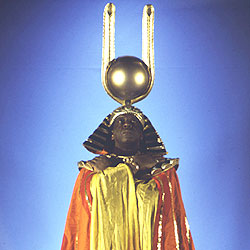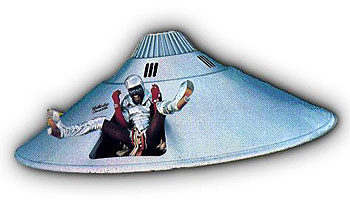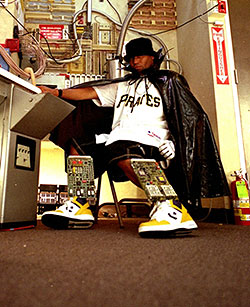A Brief History Of Black Sci-Fi Music
Published on May 30th, 2011 in: Climb Onto The Nearest Star, Issues, Music, Science Fiction |By Jemiah Jefferson
The earliest and greatest of them all was jazz bandleader Sun Ra. Best known these days for the extremely strange movie Space is the Place, released in 1974, a unique combination of concert film, parable, “blaxploitation,” and a lot of other just plain confusing stuff.

Sun Ra
The underlying message, however, is impossible to miss: Sun Ra, with the assistance of his band the Intergalactic Space Arkestra, know the only way to escape a world where the black people have little chance to get ahead is to leave the planet behind and take a leap into the unknown. Sun Ra’s philosophies are complex and multilayered, incorporating mathematics, gnosticism, afrocentrism, astral travel, immortality, and the responsibility of the individual for enlightenment.
Often mistaken for free jazz, his compositions are actually specifically and painstakingly notated and meant to be played precisely. He wrote thousands of pieces of music and released literally dozens of albums, ranging from the swing and hard bop of his early days in the 1950s, to the “space music” of later compositions such “Celestial Road,” from 1993, and “Tapestry From an Asteroid” from 1994.
A certain disillusionment with the status quo was par for the course in the late Sixties, but few other black musical artists used science fiction as commentary. One that did was Jimi Hendrix. “Third Stone from the Sun,” the instrumental track from the album Are You Experienced?, not only references Earth’s position in the solar system, but its distorted lyrics and tidal sound are meant to evoke the sounds of Star Trek.
The enthusiasm for outer-space concepts continued on the next Jimi Hendrix Experience album, Axis: Bold as Love, with the opening tracks “EXP” and “Up from the Skies” featuring the musings of extraterrestrials, disappointed with the human race. Electric Ladyland brought the antiwar song “1983 (A Merman I Should Turn To Be),” a glimpse 25 years into the future to a broken, blasted Earth, where the narrator and his girlfriend have built a machine to transform their bodies into amphibious forms, since nothing can survive any longer on dry land. It’s unlikely that you’ll hear this track on classic-rock radio any time soon, and that’s a shame; “1983” is one of the most interesting and influential tracks recorded by Jimi and the Experience, both in sound and concept.
The Parliament-Funkadelic axis was certainly my first experience with black sci-fi music (as well as a lot of other musical statements). Under the leadership of freaky dudes George Clinton and Bootsy Collins, this constantly-evolving set of blended groups has been obsessed with other planets, mad scientists, out-of-control experiments, and the magical Mothership, the spaceship of Dr Funkenstein and “his agents of Supergroovalisticprosifunkstication.”

The P-Funk Mothership,
recently acquired by the Smithsonian
How the seven-year-old me longed to climb aboard the Mothership in search of new funky life and new groovy civilizations, seeking to destroy the evil machinations of Sir Nose, D-Voidoffunk! Alas, the only way to get on the Mothership was through the sound of great songs like “Up on the Down Stroke,” “Give Up the Funk,” “Flash Light,” “Knee Deep,” and countless others.
Over a 23-year history, the group has morphed, mutated, and assimilated members as ruthlessly as the Borg, including musicians such as Maceo Parker, Bernie Worrell (later to perform with Talking Heads), and vocoder-vocalist Roger Troutman, lead singer of the funk-punk band Zapp. The P-Funk mythology is far too complex to describe adequately in the space allotted for this essay; interested parties can be referred to the Wikipedia entry, the Motherpage, or George Clinton’s site.
More recently, the Deltron 3030 project produced a self-titled album that brought explicit science fiction themes to the realm of hip-hop. Released in 2000, the album—produced by Dan the Automator and written and performed by Del the Funkee Homosapien—also features the work of DJ Kid Koala, and occasional vocal assistance from Damon Albarn, nearly comprising an arm of the first lineup of Gorillaz.
The album’s narrative, set in the year 3030, is made up of the musings of Del’s alter ego, Deltron Zero, in his battle against oppressive global corporations and his desire to be Galactic Rhyme Federation Champion. Simultaneously dystopian and defiantly upbeat, Del’s expressive voice refers to everything from mecha suits to the atmosphere of distant planetary moons. “F*** earth, I want to live on Mars,” Deltron declares, echoing the sentiments of many musicians before him. Let’s hope it’s sooner than the year 3030 before the long-promised followup album arrives . . .

Dr. Octagon
Also produced by Dan the Automator, the first song I ever heard from noted eccentric and musical genius Kool Keith, at the time he was known as Dr. Octagon, was “Earth People,” which proudly announces, “Earth people, I was born on Jupiter.” The persona of Dr. Octagon is a filthy-minded, space-faring, time-traveling mad scientist, obsessed with gory surgeries and splicing patients—and animals—together in the strangest of ways. The Octagynecologist is a strange anomaly; in a way, it is a Lovecraftian, or Cronenbergian, sci-fi hip-hop album, full of body horror, perverse humor, and a healthy dash of the absurd.
DJ Spooky, the Subliminal Kid, who borrowed his full stage name from the William S. Burroughs novel The Nova Express, has spent a large proportion of his career, like Sun Ra, exploring psychological, mythical, and transformative properties of music. However, Spooky keeps it closer to home, including work recorded in and inspired by the landscape of Antarctica, which is itself a landscape so alien to the majority of Earth’s residents that it resembles another world, with another set of rules for survival and rhythms unknown to the dwellers of the lands up north.
Most recently, Janelle Monáe has made her mark in the world of music with her own unique, and possibly the most fully-formed science fiction narrative ever created by a black performing artist. Most music critics focus on the music and Monáe’s unique look and style to the exclusion of the story being told in the present two releases, Metropolis: Suite I (The Chase) and The ArchAndroid (Suites II and III).

Janelle Monáe
In this continuing tale, a sprawling semi-opera still in progress, extraterrestrial android 57821, also known as Cindi Mayweather, has been unfortunate enough to fall in love with a human man, Anthony Greendown, and has now been marked for disassembly by the Wolfmasters, a thoroughly unpleasant-sounding group of soldiers armed with chainsaws, electrodaggers, and phasers. The android has to run for her life, and in the process of surviving and struggling, is poised to become a messiah figure for all the oppressed people on all the worlds. She hasn’t quite gotten there yet; there is still one “suite” left to be released and then the story will be complete.
In the meantime, while we’re waiting, we can obsessively rewatch Monáe’s fascinating, beautiful videos for “Many Moons,” “Tightrope,” and that amazing performance on David Letterman where her shimmying feet threaten to set the Late Night Show‘s stage on fire. Influenced by Fritz Lang’s Metropolis, Grace Jones, James Brown, and David Bowie, Monáe has made it her business to refuse conformity or easy solutions to complicated questions of identity and self-worth as an artist as well as a young, black, science-fiction loving woman in 21st century society. With craft and talent like hers, she might just have a chance to release more of us.
Time limit is exhausted. Please reload the CAPTCHA.